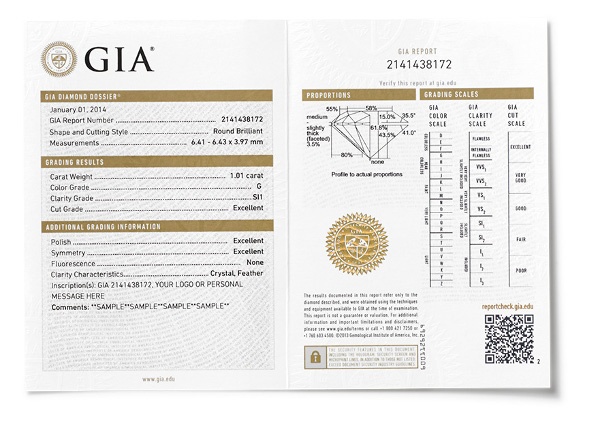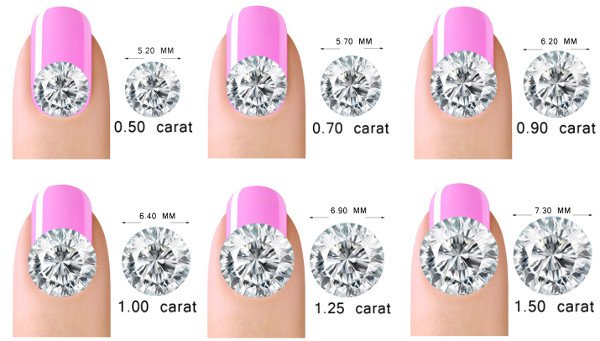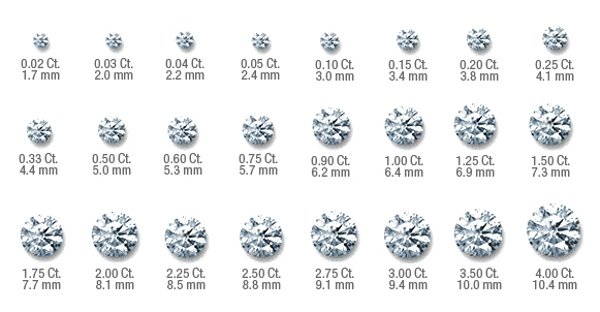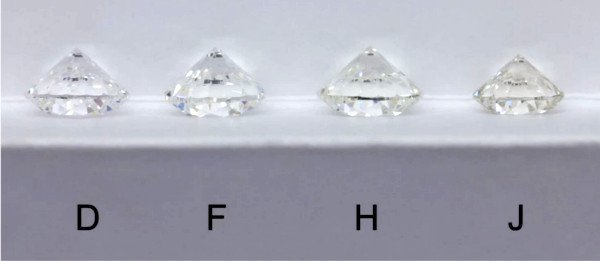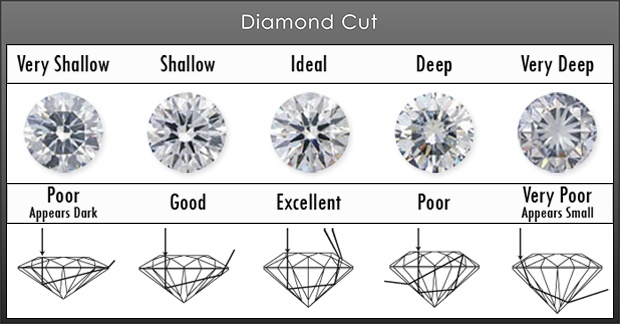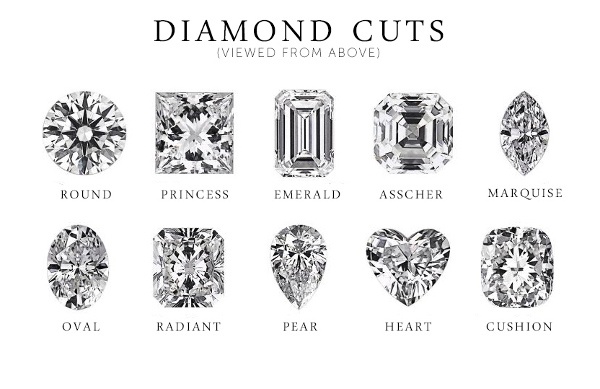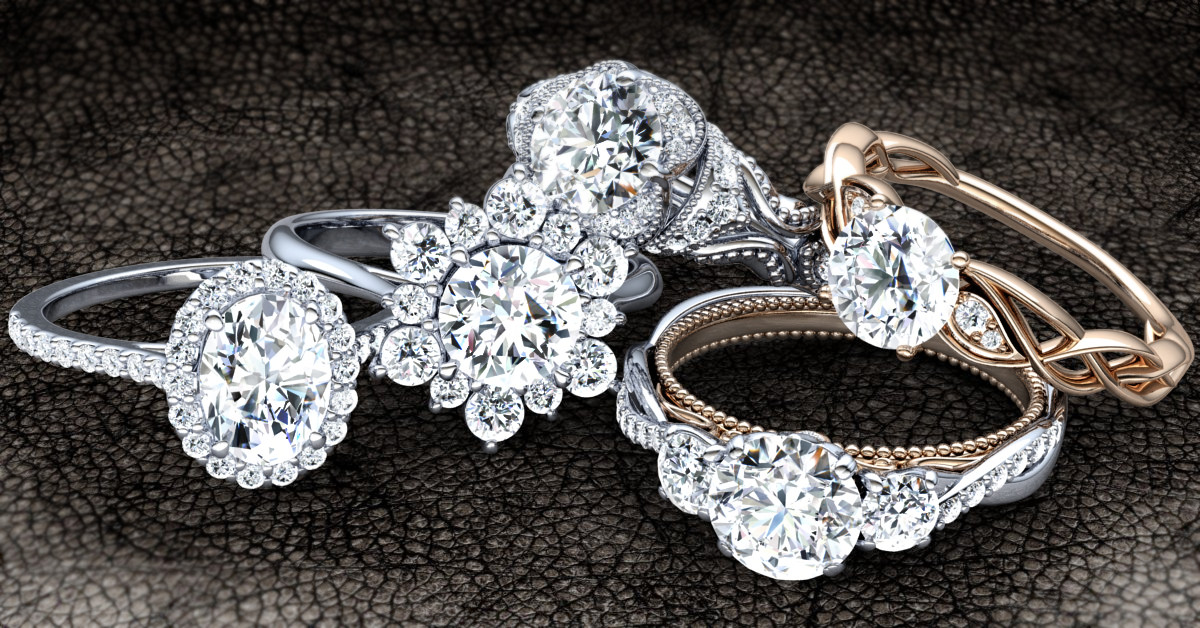
Carat, Colour, Cut, Clarity.
When you’re out diamond engagement ring shopping and you cross paths with your first diamond grading report you’ll most probably feel a bit overwhelmed.
A few characteristics (which might be Greek to you at that stage) are stated and then graded using rather nonsensical classifications;
To help diamond shoppers better understand these grades a basic framework was created, and it’s called The 4C’s Of Diamonds; Carat, Colour, Cut and Clarity.
You’ll find renditions of this rather simple 4C framework on 99% of jeweller’s websites. It’s a great systematic approach to better understanding what key variables drive and affect the appearance and price of a diamond. Spend some time on getting to grips with the 4C’s and you’re well on your way to making a more informed diamond purchase.
Unfortunately, the stock standard 4C explanation that’s scattered across the internet is way too diluted. Sure, it covers the basics, but as the size of the diamond changes, certain C’s become more or less important than others. The framework is infinitely more useful when you fix the size (carat). Especially the clarity grade is greatly affected by the size of the diamond, and can’t be properly investigated without setting a size framework.
Please keep in mind that we operate in the upper tier of the local market and all information will steer well clear of any obviously flawed diamond combinations. If we talk about “lower colour diamonds” we’ll still be in shades of predominantly white.
To get a better feel for the level and quality of our work spending some time on our Instagram page will be inspiring and leave you very comfortable with the type of projects we undertake.
If you’re into condensed content, here is our Ultimate 1 Page Diamond Buying Guide. (link)
Minimum/Recommended 1,00ct Diamond Budget
First of all, our diamond prices are excellent so these base numbers I’m about to type won’t be applicable or even relevant all round.
Depending on the shape of diamond these are the minimum amounts I would recommend allocating to the diamond part of an engagement ring purchase if you’re set on buying a 1,00ct+ size;
- Round or Oval: R60 000, preferably R70 000.
- Cushion; R50 000, preferably R60 000.
We’ve sold thousands of engagement rings over the past years and I promise you a visually pleasing 0,90ct diamond trumps a compromised 1,00ct every day of the week. Over-reaching for your diamond budget will not result in a more impressive end-product.
To better understand the strengths of these popular shapes I recommend hopping over to Which Diamond Shape Appears The Largest (link).
First C: Carat…
Carat is simply a measure of weight. 5,00ct = 1 gram.
A 1,00ct diamond is regarded as sort of an aspirational benchmark, but keep in mind it’s significantly larger than the average diamond set in engagement rings in South Africa.
In contrast, the bulk of diamonds you’ll see when browsing engagement rings on instagram, pinterest of Google Images will be 1,00ct – 3,00ct in size.
99,9% of engagement ring designs simply look nicer with a larger diamond and most jewellers would lean towards the use of larger diamonds in photo shoots.
Good news is that even those 3,00ct designs she has her heart set on can often be stunningly executed with a 1,00ct – 1,30ct diamond. This +/-1,00ct size range is very versatile.
If you’re wondering about sizes, the best way to steer your thoughts would be to visit one of our studios (Rosebank and Pretoria) and see them in person. If it’s a couple’s trip; first prize would be to have the lady try on a few sizes and see what she feels most comfortable with.
For now, if you want to grab a ruler here are some diameters to gauge the size with;
Second C: Colour.
Although “L” and “M” colour diamonds offer excellent value, we rarely sell 1,00ct+ diamonds under “K” colour. If a budget doesn’t quite reach to a 1,00ct “K” colour, everyone seems to drop the size to a 0,90ct before they drop colour to “L” or “M”.
I think that’s a good, sane way of going about it.
A 1,00ct+ diamond will be the focal point of an engagement ring and you’d want the diamond to appear as white as possible within your budget range.
Generally I recommend you don’t line up more than 3 or 4 diamond colours when out viewing diamonds. There’s no reason to create stark contrasts, to start at the bottom (K) and move up one or two colours at a time.
So line up +/- 1,00ct “I”, “J” and “K” colour diamonds right next to each other. If the minute tint in the “K” colour bothers you move up to “J” or “I”, and put the “K” away. If you’re still not satisfied add “G” and “H” to the mix. You’re spending a good amount of money and should absolutely feel comfortable with the diamond you’ll be setting in an engagement ring.
Size is not the sole ruler of this kingdom.
How Low Can You Go?
Round brilliant “K” colour diamonds, especially with strong blue fluorescence (which improves the perceived colour) are great buys and absolutely worth considering if you’re prioritising size.
Ovals and cushions concentrate colour. Whenever you see very rare diamond that has recently been on auction it’s most probably a rare colour like blue, red or purple and will be cut into a cushion or oval to intensify the colour.
A “K” colour cushion will look about 2 shades lower than a “K” colour round brilliant diamond. For these shapes (cushion and oval) I would recommend “I” and better as colour.
At the top end…(D-E-F) Colours.
For the sake of full transparency; I’ve been working daily with diamonds for many years. There is no way I will be able to distinguish between a “D” colour diamond and a “F” colour diamond if we’re out and about and I can’t view them in a well known controlled environment. That would be – loose/unset, under white light directly next to each other on a white piece of paper.
F-G-H-I-J-K colours are where you’ll find a great appearance-price-ratio. You can also rest assured they’ll all be shades of “white” without any prominent tinges of yellow or brown.
Third C: Cut (Regardless of size, this is the most important C)
Diamond cut is often confused with the diamond shape (Round, oval, square). You’ll even find this error in way too many 4C information sheets.
Here are the most common diamond shapes;
A diamond has very special light reflection and refraction characteristics. You can think of a diamond’s facets (sides) as internal mirrors that reflect light internally to and from the diamond’s environment.
Through decades scientists and gemologists have experimented with the optimal placement and proportions of diamond facets. The modern brilliant cuts have been designed to ensure that a diamond optimally reflects light when cut to these pre-determined proportions and dimensions.
Your 1,00ct diamond showpiece should have maximum life, fire and brilliance. If the diamond has been poorly made the size, clarity and colour doesn’t matter… you’re stuck with what looks like a dull piece of glass.
By using innovative optical measuring instruments, the GIA has engineered a process to determine a diamond’s overall cut quality accurately by comparing a diamond to over 38.5 million proportion combinations they have measured and graded. A cut grade is then issued by their FacetWare technology;
- Excellent (Optimal light reflection and refraction)
- Very Good (Very close to perfect – mostly indistinguishable from Excellent cut unless you know your diamond very well.)
- Good (Recently this has become a very broad grade. Some are fine, some look terrible. Rather avoid).
- Fair (Nope.)
- Poor (Nope.)
Excellent cut diamonds don’t carry a massive premium over properly cut VG (Very Good) options. Unless you’re convinced a jeweller is extremely knowledgable this small premium will be a worthwhile insurance policy to ensure the diamond is well made.
Fourth C: Clarity (Greatly dependent on the size of the diamond)
While reading a few articles that discuss diamond clarity I was baffled at the omission of the fact that the size of the diamond plays a tremendous role in the grading of clarity.
Clarity refers to the level and/or amount of inclusions/imperfections in a diamond. It’s measured at 10X magnification and is classified and graded by human beings. Magnify any diamond by a factor of 100X and you’ll find impurities. Don’t let “flawless” clarities appeal to the poet in you.
Online clarity charts are usually a bit dramatic, but the following image will illustrate what is meant by clarity, both high and low.
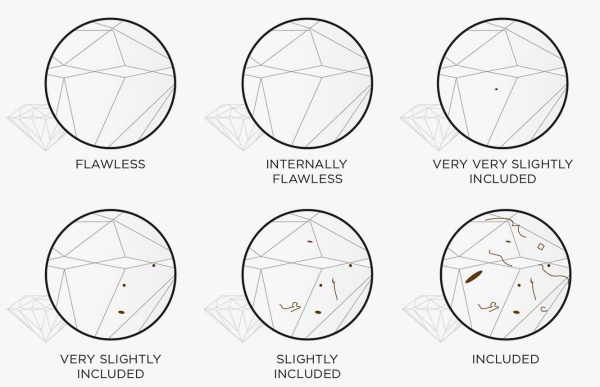
With no two diamonds being alike the standards for what constitutes any clarity grading is vague. The grader considers the location of the impurities, the type, the amount and the effect it has on the appearance of a stone.
As a rule of thumb “VS2 and better” has always been a loose guarantee that your diamond will appear flawless to the naked eye (referred to as eye-clean). As cliched as it is – no one is walking around with a magnifying glass inspecting diamonds at parties. Eye-clean is good enough when it comes to clarity. Rather optimise for colour or size, while keeping cut at VG or EX.
A round diamond has 58 facets (including the culet). Obviously these light reflecting and refracting facets are way more condensed in a small stone. The larger the diamond is, the easier it gets to look into the heart of the crystal, see each facet and spot imperfections. To illustrate this fact we’ve 3D scaled a diamond to X5 size. As you can imagine you’ll very easily see into a diamond of this size;
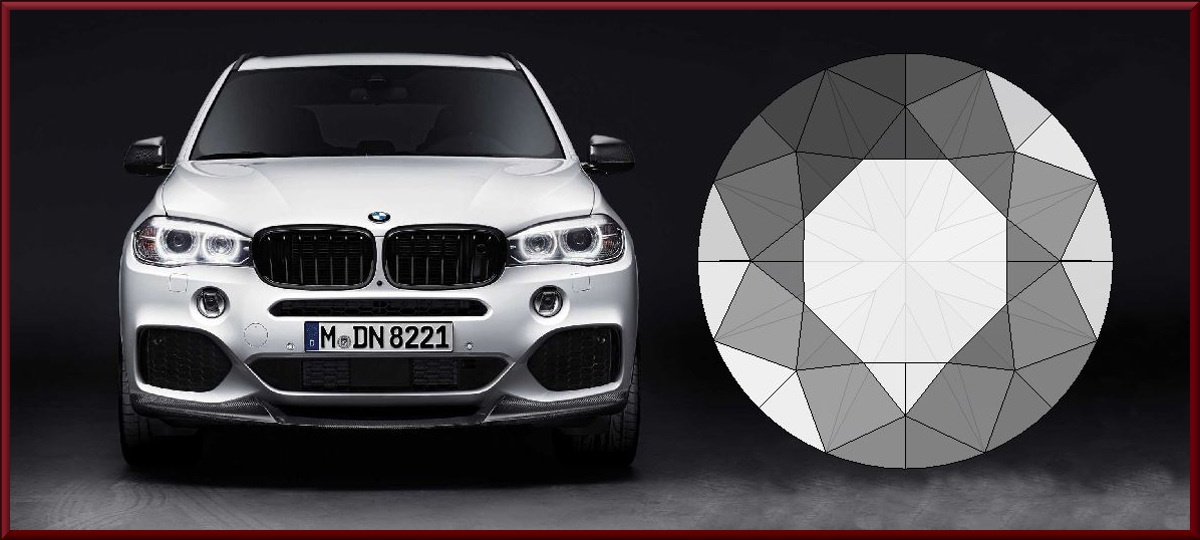
If you’re buying a 0,50ct diamond chances are that even some SI2 diamonds will still appear eye clean. If you 3D scale that very same 0,50ct to the size of a 2,00ct you’re hit with a double set of issues – the same inclusions are significantly larger (maybe visible to the naked eye) AND the less concentrated facet layout makes inclusions easier to see.
So, on 2,00ct diamonds we have a blanket recommendation of VS1 or better on clarity. But most VS2 diamonds will be eye-clean on a 1,00ct size… IF they have been properly and accurately graded. At a 1,00ct size it’s worth it to stick to GIA graded diamonds. They’re the diamond grading benchmark.
To even further your peace of mind; we only sell eye-clean diamonds and if you find our quotes low on SI-clarity options, we very rarely stock them since they’re often visibly included these days.
A few short years back I would say there is no way a laboratory uses 3D scaling for grading the clarity of diamonds.
Unfortunately, the grading standards are not cast in stone. Diamond imaging has taken massive strides in the past few years and I’m convinced grading laboratories are putting these illustrated 3D technologies to work.
Let’s allow a 3% inclusion in a 0,50ct diamond, and then see how this same percentage looks on a 1,00ct diamond and even on a 2,00ct.
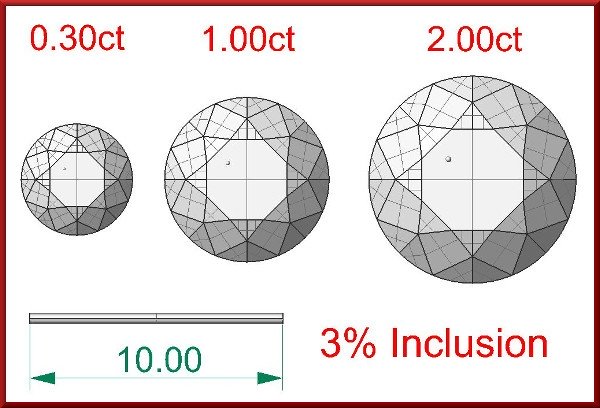
*A 3% area inclusion becomes significantly more visible as size increases.
Clarity is an area where the integrity and knowledge of a jeweller is of paramount importance. Don’t rest assured on the assumption that a VS-clarity diamond will be eye-clean. If any jeweller shrugs off this issue they’re way out of tune with the 1,00ct market.
Why I think we’re the best fit for 99% of 1,00ct buyers
Most jewellers with business models similar to ours will say their key core competence is their pricing. That’s why you’ll see the bargain bin ads swearing they’re the cheapest in the world. They’re not. Two diamonds might have the exact same 4C grading, but one obviously visually outperforms the other.
Our core competence is the meticulous way in which we source diamonds. Although we stick to GIA certificates, and recently have grown fond of HRD, we’ll never in ‘n million years buy a diamond on the certification alone.
Firstly, we stick to buying from the largest diamond cutting and polishing factories in the world. They have the expertise, experience and capital to finish diamonds to the highest of standards. Further, whenever we source diamonds we request video material and HD imaging of every single diamond we’re interested in. With VS gradings being broader than they were a few years ago we daily eliminate VS2 and even VS1 diamond options in supplier’s stock lists that simply won’t be eye-clean.
Sure, these visibly included VS2 diamonds are cheaper than the true eye-clean VS2/VS1 diamonds. Sourcing “cheap” diamonds is easy. Just know, even if you’re comfortable with a poor VS2 diamond we still won’t sell it.
*That’s where we lose the last 1% of 1,00ct shoppers. A price I’ll gladly pay to keep the quality top notch and undisputable.
What our 1,00ct customers know is that we’ve taken hours to sift through hundreds of diamonds available at the massive factories we import from. We don’t compromise on cut. We don’t compromise on clarity. We don’t hide behind certificates.
Every diamond option offered to you has been thoroughly checked by a few sets of very experienced eyes.
Our final commitment to quality is clearly demonstrated in our upgrade policy;
Whenever you wish to upgrade a diamond purchased from Poggenpoel, we’ll offer 100% credit for the amount you initially paid. We’ll quote you on the higher specification diamond and you can merely pay in the difference. No loss on any diamond purchased from us.
This guarantees that we’ll never sell a diamond in an opportunistic deal. This upgrade policy comes down to us never selling a diamond we wouldn’t repurchase any day and carry it in our inventory. That’s commitment.
Do yourself a favour and come see how finely curated our inventory is. You’ll know you’ve found your jeweller.
Thank you for reading. Feel free to reach out to me directly on johan@poggenpoel.com with any questions. I’ll also be available in the comments below.
You’re also more than welcome to visit us for a coffee, even if you have no short-term buying plans. I understand these things take some time and fine planning.
Posts worth reading;
- Optimising Your R100 000 Engagement Ring Purchase
- Which Diamond Shape Appears The Largest
- The Price of a 1,00ct Engagement Ring in South Africa
- Not So Independent Diamond Grading Certificates
Take care.
Johan Poggenpoel
Co-Founder.

